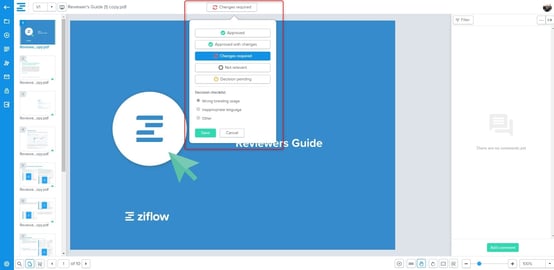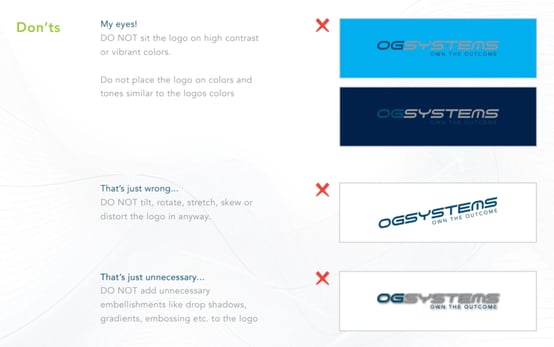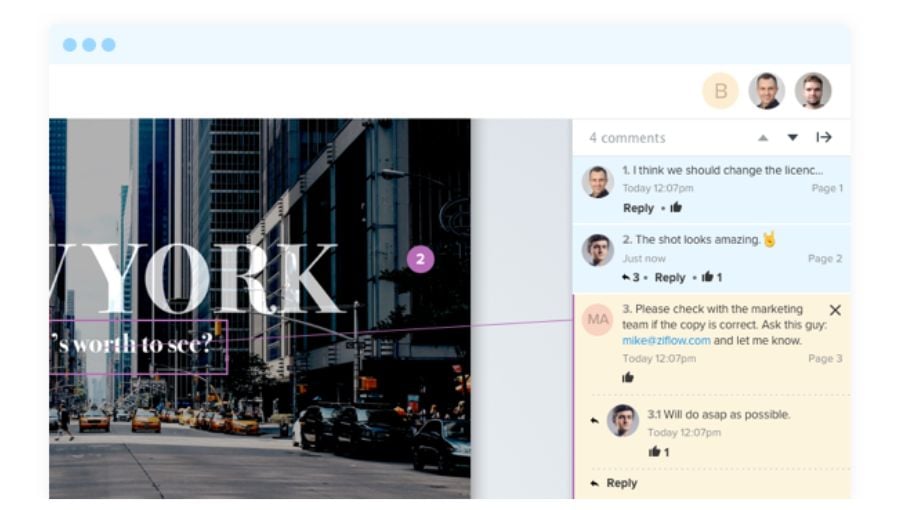Brand governance is more than just maintaining a uniform logo or color scheme. It is a comprehensive strategy that keeps your brand's essence consistent across all marketing channels and touchpoints. The importance of this strategy lies in its power to establish brand recognition and trust, creating an environment where your audience knows exactly what to expect from your brand.
By adopting a solid brand governance approach, your marketing team operates in sync, driving the core message of your brand with clarity. It's the beacon that guides your marketing initiatives, ensuring that every campaign, advertisement, and social media post is unmistakably "you."
What we'll cover
Table of contents
Modern brand governance involves letting go of control, and allowing all teams to have their say on how the brand’s assets can be used. But that doesn’t mean everything has to change. Sacred elements can stay sacred, and serve as start points for teams to be creative. Plus this loosening of control can help cut costs, improve efficiency and help your band adapt to long-term changes.
What is Brand Governance?
What was brand governance before, and how has it changed? What do you have to do now that you didn’t have to before?
Let’s start by looking at what brand governance used to mean, compared with what it means now. You’ll find both the old and new definitions have some things in common, along with a few key differences.
The Old Way
Brand governance was about ensuring brands were being presented correctly. Wherever a brand element appeared—such as a logo, color scheme or marketing copy—the brand governance team would have been responsible for ensuring all brand assets followed the “rules” your business had previously established.
No inconsistent tone of voice here, no wrongly-sized logo there. There was a lot of control over how these elements could or couldn’t be used. But that’s changed.
The New Way
In today’s world of social media and agile marketing, brand governance teams no longer have as much control as they used to.
There are lots of stakeholders who can influence how your brand is perceived by others, from your own employees to external design teams. But just because you have less control, that doesn’t mean you should let go of everything that makes your brand distinctive. In fact, you shouldn’t. You just need to be willing to let others use less sacred brand elements in their own way.
The Brand Governance Role Has Changed
Your governance team now has less control over how your brand is presented. Many see this change as necessary. In a recent study of 100 brand leaders, 93% say they’re moving beyond the role of "brand police". And in the words of Dr Cristina de Balanzo, "Brands belong to people, not marketing."
Nowadays, there are many stakeholders who have a say on what your brand is or isn’t. It’s no longer restricted to just the governance team.
So, how can your company keep up with this evolution? We have several suggestions for adapting to the new way brand governance is done:
- Stop policing your brand, and stop trying to control every part of it
- Decide what the sacred parts are, and explain clearly how these can and can’t be used by different teams
- Empower teams to use non-sacred brand elements creatively
- Encourage collaboration between teams and other stakeholders
- Start listening to what others are saying about your brand, and take their feedback on-board
- Remain open to change based on what others say about your business
Pillars of Brand Governance
To protect your brand’s sacred elements, you’ll need to get the brand governance pillars together. Think of this as insurance for any changes to your brand, or during any rebranding exercise or merger with another company. This will help you to protect it for years to come.
There are four key brand pillars:
- People
- Process
- Training
- Technology
People
Who’s in your brand team? Who’s driving the strategy? Who’s making the important choices, and who decides whether changes to your brand are approved? Is there anyone else, such as agency partners or vendors, who can help define or promote your brand? Is there anyone else within your business who may be able to help? What do external partners add? Does this overlap with your business’s internal processes in any way?
Iron out any overlaps you don’t want to make sure no investments or resources are going to waste.
Process
When you collaborate or merge with another business, you may find that you have historically different processes, systems and other ways of doing things in place.
How will you combine or reconcile these? How do you and they approach creating and documenting new and old brand assets? What are your approaches to approvals and reviews? What feedback loops are in place? Is there a distinct direction for bottom-up communication? For global companies, are international teams collaborating in a way that stops them from re-defining what you’re doing at every turn?
Map the current process and look for gaps, risks and chances to save costs and boost efficiency.
Training
How are your new employees being educated and engaged with when it comes to your brand’s strategy? What are the onboarding, managing and evaluating processes for vendors and agencies like at the moment? Is there any way for you to improve training in order to help employees, vendors and agencies be more comfortable and confident in becoming stewards of your brand? Can you make this more efficient?
Technology
What tools and technology are you using to support the management of your brand? How are you using them, and what for? What’s working well, and what could be improved, when it comes to workflow automation, asset creation, and internal team workflows? How about your educational materials and templates? Could your toolkit be rationalized, expanded or adjusted in any way?
Each of these pillars presents you with opportunities to make your processes more efficient and to cut costs. And that’s a win for you and your business. When you audit these pillars, your brand team can use the assessment to tighten up their governance in a way that promotes better understanding, integration, consistency and quality, and for protecting the acquisition investment of your brand.
5 Guiding Principles of Modern Brand Governance
Brand governance may have changed, and you now have less control over it. But that doesn’t mean there aren’t new best practices for how this should be approached. When you have these best practices in place, it’ll provide you with confidence for letting go of that control and trusting other stakeholders to use your assets in a way that doesn’t compromise the sacred aspects of a brand’s identity.
There are five key principles that can help guide your brand team:
- Act as custodians
- Provide clear guidelines
- Set up a review and approval process
- Be flexible
- Document everything
Act as Custodians
Your governance team is no longer here to police every aspect of your brand. Rather, it should offer creative prompts to those who can be flexible with certain elements.
Brand custodians should make it clear what can be experimented with, as well as what must remain unchanged. In this sense, they can assist with projects where brand elements are going to be used. They can help ensure the rules are as visible as possible while providing creative inspiration.
Provide Clear Guidelines
Employees and vendors need to be able to take some creative license with parts of your brand. You may feel nervous about letting go of so much control. But having clear brand guidelines that are easy to access can help.
Brand guidelines will allow new employees to educate themselves about your brand, and learn what’s adaptable—and what isn’t—along the way. You could also allow PR and press teams to have access to these guidelines, so they know how to use your brand elements without having to contact you and ask for permission.
Set Up a Review and Approval Process
You can use online proofing software to speed up the review and approval process. This works for creative brand elements, promoting collaboration, and helps ensure teams have the most up-to-date access to your brand’s assets.

Ziflow comes with a number of features that help creative teams cut the review and approval timeframe by up to 50%. The result is faster shipment of brand-compliant assets.
Be Flexible
Your brand guidelines are something that should change over time. Gather feedback, test new features, and make changes based on what’s well-received and what isn’t. And remember branding experts aren’t the only one who have a say in this. All employees, specializing across all fields, will have thoughts too.
Document Everything
For a healthy governance process, you need a healthy feedback loop about what the brand is doing. This will allow you to react speedily to new customer demands and challenges that arise in particular markets.
Keep a note of metrics like brand valuation, revenue, sales, morale, retention and reputation. And anything else you feel is relevant to your brand. Use this to improve your processes as time goes on.
Also, keep a record of all of your brand governance documents and assets. This can include:
- Brand guidelines
- Style guidelines
- Web guidelines
Brand guidelines
This offers high-level, abstract guidance on your brand’s strategy. It may also include several versions of your brand’s visual style. For example, your brand may refresh it’s identity periodically, but its value and message will generally remain consistent.
Style guidelines

Your style guide will probably be made up of documents that offer guidance on how teams should represent your brand visually, as well as tips for using its design and tone of voice. Many businesses tend to have several styles throughout their lifetime, and may have separate guidelines for specific products and services.
Web guidelines
There are normally two levels to web guidelines: design and atomic design. The first, design, usually covers an established set of visual elements that have been created to embody your brand. Plus advice on how to use them tactically.
The second, atomic design, is a bit more intricate and detailed. It focuses on the smaller elements, such as fonts and buttons, and the rules around how they can be used. This includes combining them into components and other interfaces. It helps keep web pages consistent, and supports the cascading of changes gracefully throughout your system.
Final Thoughts on Brand Governance
Brand governance has changed, but that’s not a bad thing. It can provide you with opportunities to become more efficient, cut costs and drive creativity and morale among employees and teams. Letting go of control over certain brand aspects can feel daunting. But with a clear set of guidelines about what’s adaptable and what isn’t, teams can be free to experiment with your brand within set limits. Your brand gets to evolve and adapt in a changing world, without compromising any of its uniqueness.
Your blog post content here…




